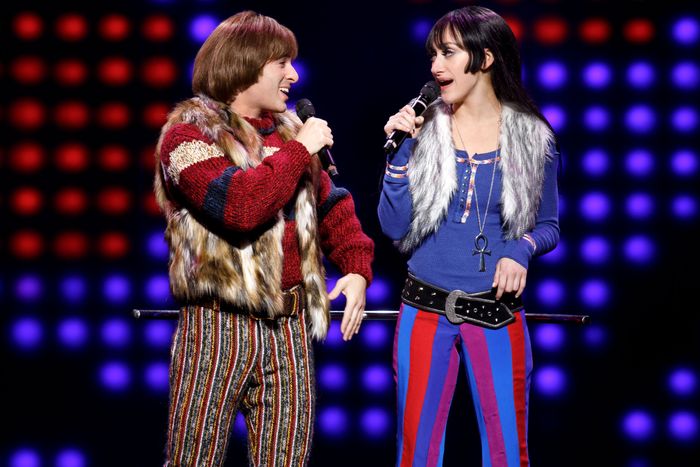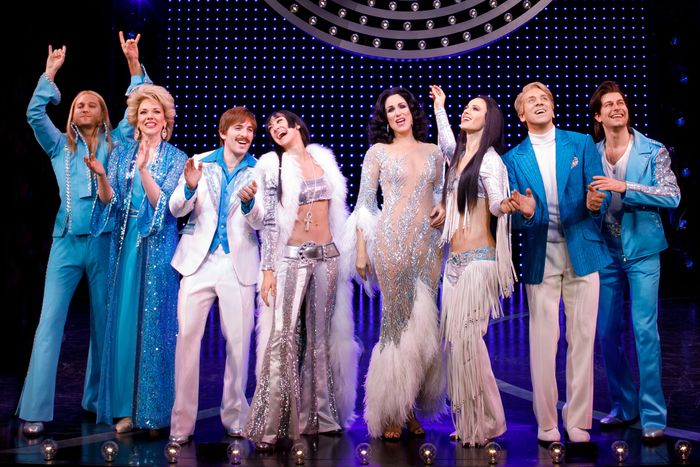
Broadway’s The Cher Show stars three women of different ages in the title role, but the fourth lead may as well be the costumes. In keeping with Cher’s close relationship with costume designer Bob Mackie, who also worked on the musical, The Cher Show incorporates more than 683 costumes, counting those used on understudies, with nearly 3,500 costume pieces, and 6,500,000 feathers. There are more than 400 quick changes, often involving the Chers themselves as they travel along a history of tight-fitting, often-recognizable bodysuits. “Our goal was to never have Cher leave the stage,” director Jason Moore said, which means the trio of Chers have to cycle through their changes quickly as they trade off with each other. “There’s 50 years of story and a lot of clothes to pack into a small space of two hours.”
There’s as much choreography going on out of sight from the audience as there is onstage. The Cher Show’s wardrobe supervisor Lee Austin has a chart that tracks the location and timing of each quick change — the kind that happens without an actor going back to their dressing room — that he uses to manage the chaos of dressers and actors in the wings, or in some cases, behind the walls of the show’s mirrored set. “My chart for this show is five feet long,” Austin said. “My average chart is maybe a foot and a half.”
The fastest change takes place in seven seconds, when Teal Wicks, who plays “Lady” Cher in the middle of her career, changes out of a pair of leggings and a black leather jacket and into a pink-striped dress in a sequence of costume changes that occur as Sony and Cher’s Las Vegas show becomes more and more popular. The show added the sequence after its out-of-town tryout in Chicago, which was originally written with two costume changes until, according to Moore, Mackie himself insisted that “if she’s going to come out four times, it has to be four different dresses.”
While the sheer number of costumes was its own issue, Austin and Moore also had to find ways to work in specific Mackie creations that they knew the audience would want to see. One of the most involved sequences requires a set of seven dressers, who help Stephanie J. Block (“Star” Cher, the oldest) into her famous Oscars dresses, while the Micaela Diamond (“Babe” Cher, the youngest) reenacts the title character’s acting career. Another group number has the ensemble members come out one by one, each wearing an extremely elaborate Mackie design. “The clothes are big,” Austin said of that scene, which has dressers hidden behind mirrors onstage helping the cast into their costumes. “Some of the headdresses can be 12 to 15 feet in length, those have to be shuttled in at the last minute, and then the change happens.”
Not all of the costumes are so elaborate. Many other Cher outfits are bodysuits that hew within a hair’s-breadth of her skin, and take some effort to get into. There, the show started to prepare its leads in advance, having the three actresses work with Mackie in numerous costume fittings where, once the base of the suit was done, he would “draw the beading pattern on the body,” according to Austin. Then, even if the outfit was a body stocking, the team found ways to make it possible for each Cher to get in and out of it quickly. “I use over 2,000 magnets on the show,” Austin said, which act as a more efficient substitute for zippers, snaps, or Velcro.
As the show progresses, the costume changes become even more difficult, simply because, as Moore puts it, “actors sweat a lot.” “They’re working really hard,” he said. “It’s those skintight ones that are just hard if you’re a sweaty normal human being, forget even that you’re dancing.” At that point, there need to be more dressers on hand to try to help things go smoothly, and make sure no one damages the costumes. “We don’t have time to towel them down, but that’s why we have so many people on certain changes,” Austin said. “We try and powder when we can, but it really is just force the clothes on. Just get them on.”
Considering the amount of blood, sweat, and glitter that goes into the show, the costumes require nearly as much rest and maintenance as the average eight-day-a-week performer. In addition to a team of 15 dressers, Austin oversees two full-time stitchers, two full-time beaders, and 19 maintenance people to keep the costumes in good condition. “I also have a laundry person that works 12 hours a day,” he said. “Most of the show has to be hand-washed and then air-dried.”
While The Cher Show opened at the beginning of December, new costumes will continue to appear in it as it performances continue, specifically on understudies and swings (who cover several rolls) as they appear onstage. “We now are having new clothes coming into the production and they’ll continue to come in probably the end of March,” Austin said. “So our numbers are just going to grow.”




